Management Accounting Report: Eastern Engineering Co. Ltd Analysis
VerifiedAdded on 2022/11/30
|17
|4387
|61
Report
AI Summary
This management accounting report provides a comprehensive analysis of various aspects of management accounting, focusing on Eastern Engineering Co. Ltd. The report begins with an introduction to management accounting, its essential requirements, and a comparison with financial accounting. It then delves into different management accounting reporting methods, including performance reports, inventory reports, and cost accounting reports. The core of the report involves a detailed examination of costing techniques, specifically marginal and absorption costing, with calculations and income statement preparation. Furthermore, the report explores the advantages and disadvantages of planning tools used for budgetary control and concludes with a comparison of how organizations adapt management accounting systems. The report uses Eastern Engineering Co. Ltd as a case study to illustrate the practical application of these concepts.
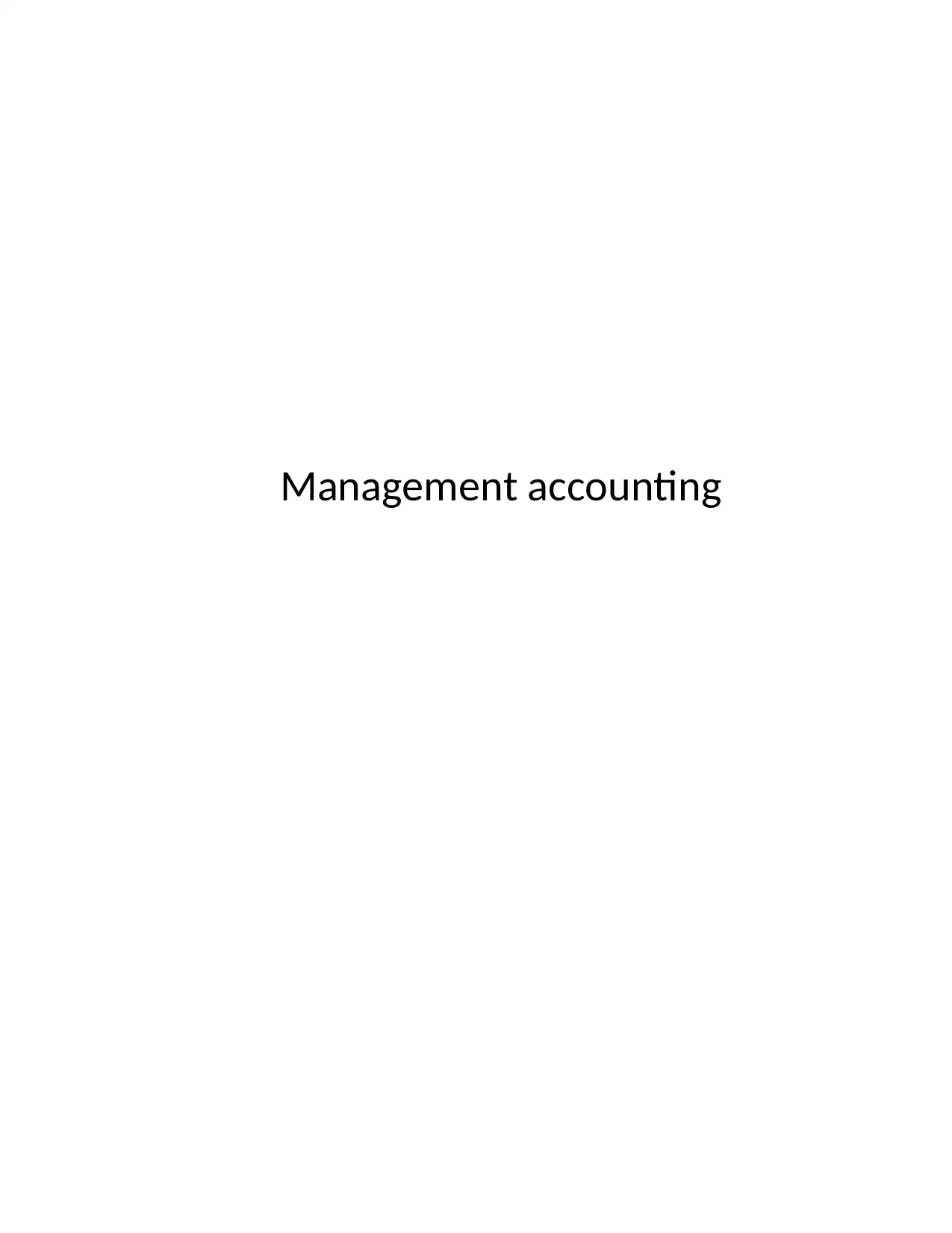
Management accounting
Paraphrase This Document
Need a fresh take? Get an instant paraphrase of this document with our AI Paraphraser
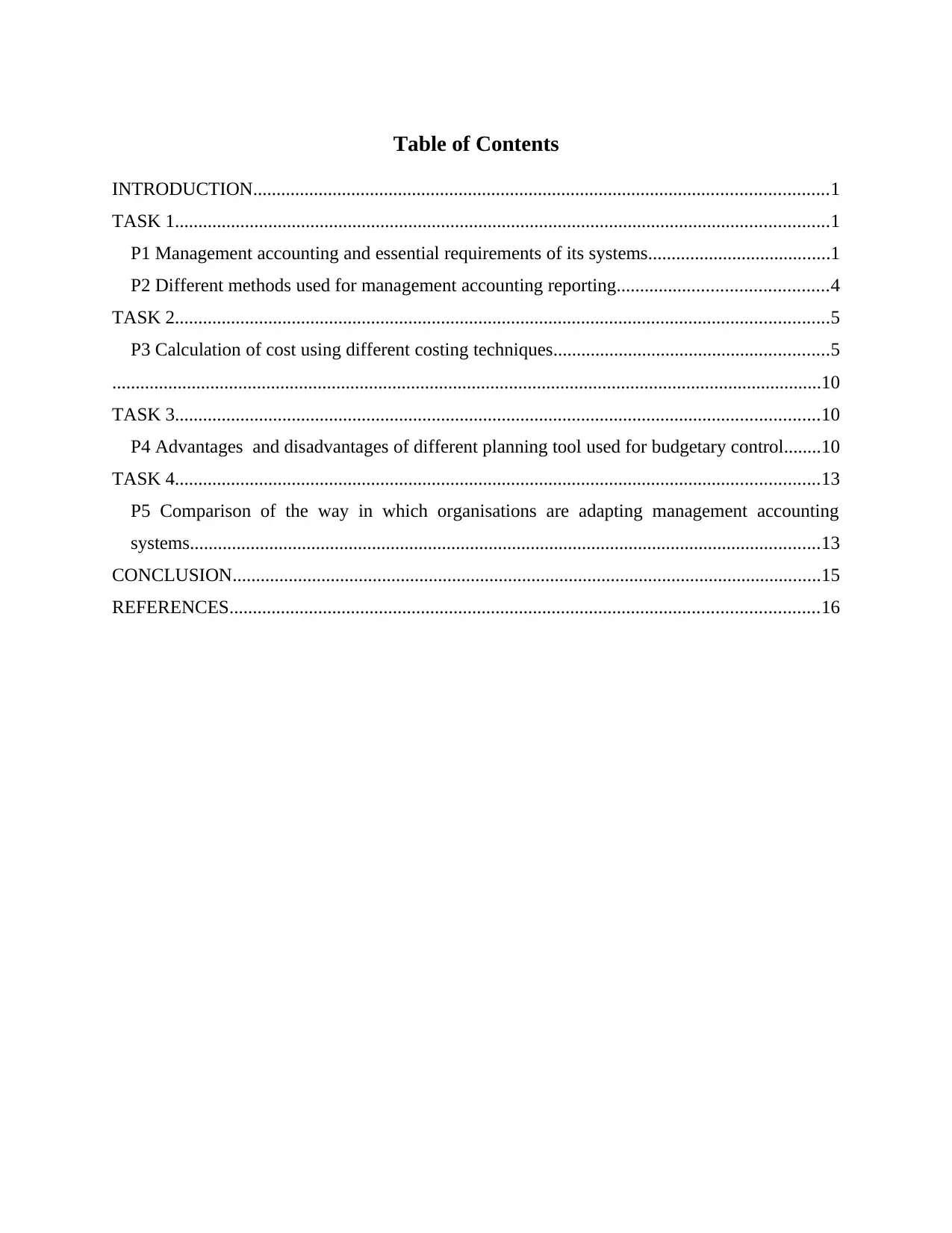
Table of Contents
INTRODUCTION...........................................................................................................................1
TASK 1............................................................................................................................................1
P1 Management accounting and essential requirements of its systems.......................................1
P2 Different methods used for management accounting reporting.............................................4
TASK 2............................................................................................................................................5
P3 Calculation of cost using different costing techniques...........................................................5
........................................................................................................................................................10
TASK 3..........................................................................................................................................10
P4 Advantages and disadvantages of different planning tool used for budgetary control........10
TASK 4..........................................................................................................................................13
P5 Comparison of the way in which organisations are adapting management accounting
systems.......................................................................................................................................13
CONCLUSION..............................................................................................................................15
REFERENCES..............................................................................................................................16
INTRODUCTION...........................................................................................................................1
TASK 1............................................................................................................................................1
P1 Management accounting and essential requirements of its systems.......................................1
P2 Different methods used for management accounting reporting.............................................4
TASK 2............................................................................................................................................5
P3 Calculation of cost using different costing techniques...........................................................5
........................................................................................................................................................10
TASK 3..........................................................................................................................................10
P4 Advantages and disadvantages of different planning tool used for budgetary control........10
TASK 4..........................................................................................................................................13
P5 Comparison of the way in which organisations are adapting management accounting
systems.......................................................................................................................................13
CONCLUSION..............................................................................................................................15
REFERENCES..............................................................................................................................16
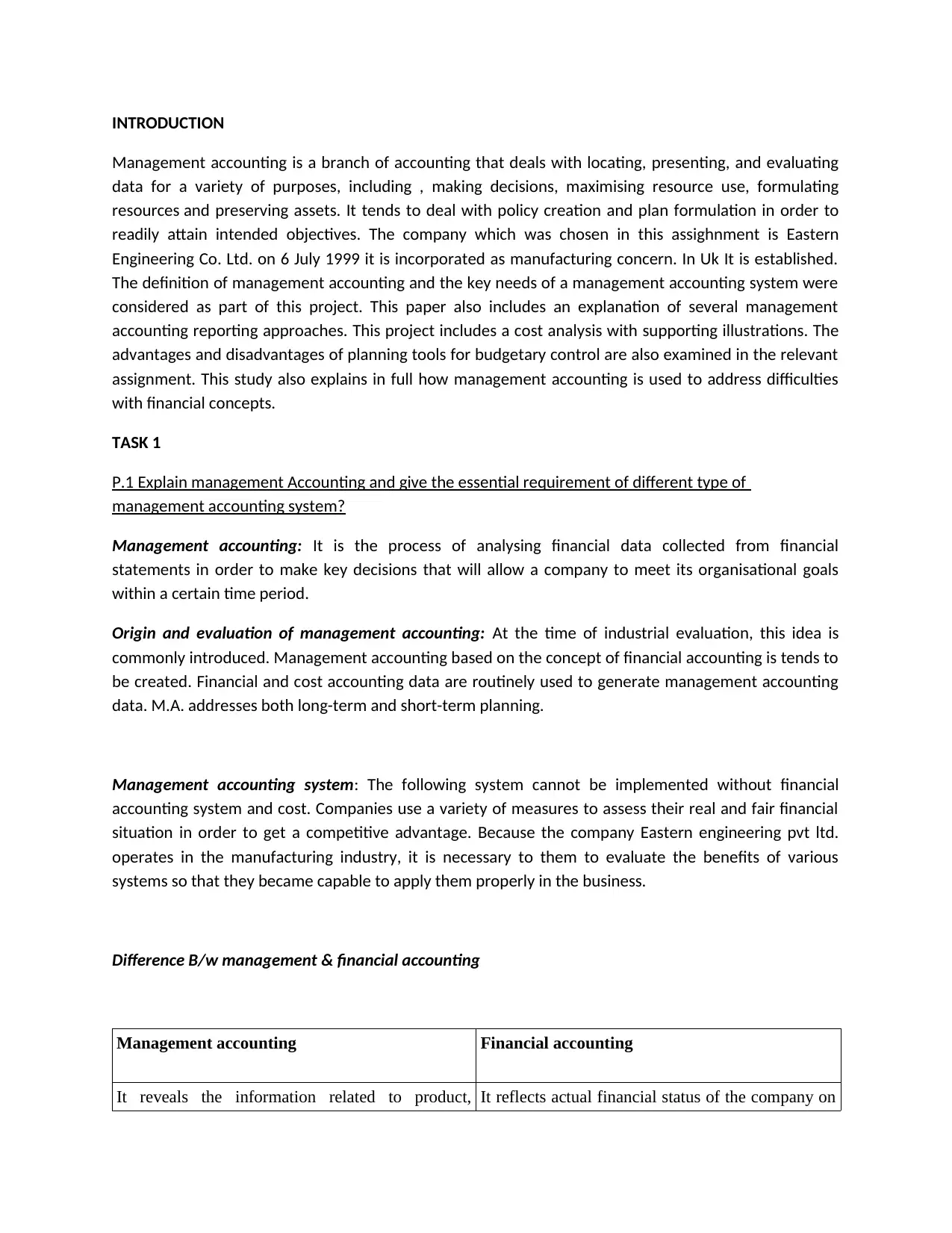
INTRODUCTION
Management accounting is a branch of accounting that deals with locating, presenting, and evaluating
data for a variety of purposes, including , making decisions, maximising resource use, formulating
resources and preserving assets. It tends to deal with policy creation and plan formulation in order to
readily attain intended objectives. The company which was chosen in this assighnment is Eastern
Engineering Co. Ltd. on 6 July 1999 it is incorporated as manufacturing concern. In Uk It is established.
The definition of management accounting and the key needs of a management accounting system were
considered as part of this project. This paper also includes an explanation of several management
accounting reporting approaches. This project includes a cost analysis with supporting illustrations. The
advantages and disadvantages of planning tools for budgetary control are also examined in the relevant
assignment. This study also explains in full how management accounting is used to address difficulties
with financial concepts.
TASK 1
P.1 Explain management Accounting and give the essential requirement of different type of
management accounting system?
Management accounting: It is the process of analysing financial data collected from financial
statements in order to make key decisions that will allow a company to meet its organisational goals
within a certain time period.
Origin and evaluation of management accounting: At the time of industrial evaluation, this idea is
commonly introduced. Management accounting based on the concept of financial accounting is tends to
be created. Financial and cost accounting data are routinely used to generate management accounting
data. M.A. addresses both long-term and short-term planning.
Management accounting system: The following system cannot be implemented without financial
accounting system and cost. Companies use a variety of measures to assess their real and fair financial
situation in order to get a competitive advantage. Because the company Eastern engineering pvt ltd.
operates in the manufacturing industry, it is necessary to them to evaluate the benefits of various
systems so that they became capable to apply them properly in the business.
Difference B/w management & financial accounting
Management accounting Financial accounting
It reveals the information related to product, It reflects actual financial status of the company on
Management accounting is a branch of accounting that deals with locating, presenting, and evaluating
data for a variety of purposes, including , making decisions, maximising resource use, formulating
resources and preserving assets. It tends to deal with policy creation and plan formulation in order to
readily attain intended objectives. The company which was chosen in this assighnment is Eastern
Engineering Co. Ltd. on 6 July 1999 it is incorporated as manufacturing concern. In Uk It is established.
The definition of management accounting and the key needs of a management accounting system were
considered as part of this project. This paper also includes an explanation of several management
accounting reporting approaches. This project includes a cost analysis with supporting illustrations. The
advantages and disadvantages of planning tools for budgetary control are also examined in the relevant
assignment. This study also explains in full how management accounting is used to address difficulties
with financial concepts.
TASK 1
P.1 Explain management Accounting and give the essential requirement of different type of
management accounting system?
Management accounting: It is the process of analysing financial data collected from financial
statements in order to make key decisions that will allow a company to meet its organisational goals
within a certain time period.
Origin and evaluation of management accounting: At the time of industrial evaluation, this idea is
commonly introduced. Management accounting based on the concept of financial accounting is tends to
be created. Financial and cost accounting data are routinely used to generate management accounting
data. M.A. addresses both long-term and short-term planning.
Management accounting system: The following system cannot be implemented without financial
accounting system and cost. Companies use a variety of measures to assess their real and fair financial
situation in order to get a competitive advantage. Because the company Eastern engineering pvt ltd.
operates in the manufacturing industry, it is necessary to them to evaluate the benefits of various
systems so that they became capable to apply them properly in the business.
Difference B/w management & financial accounting
Management accounting Financial accounting
It reveals the information related to product, It reflects actual financial status of the company on
⊘ This is a preview!⊘
Do you want full access?
Subscribe today to unlock all pages.

Trusted by 1+ million students worldwide
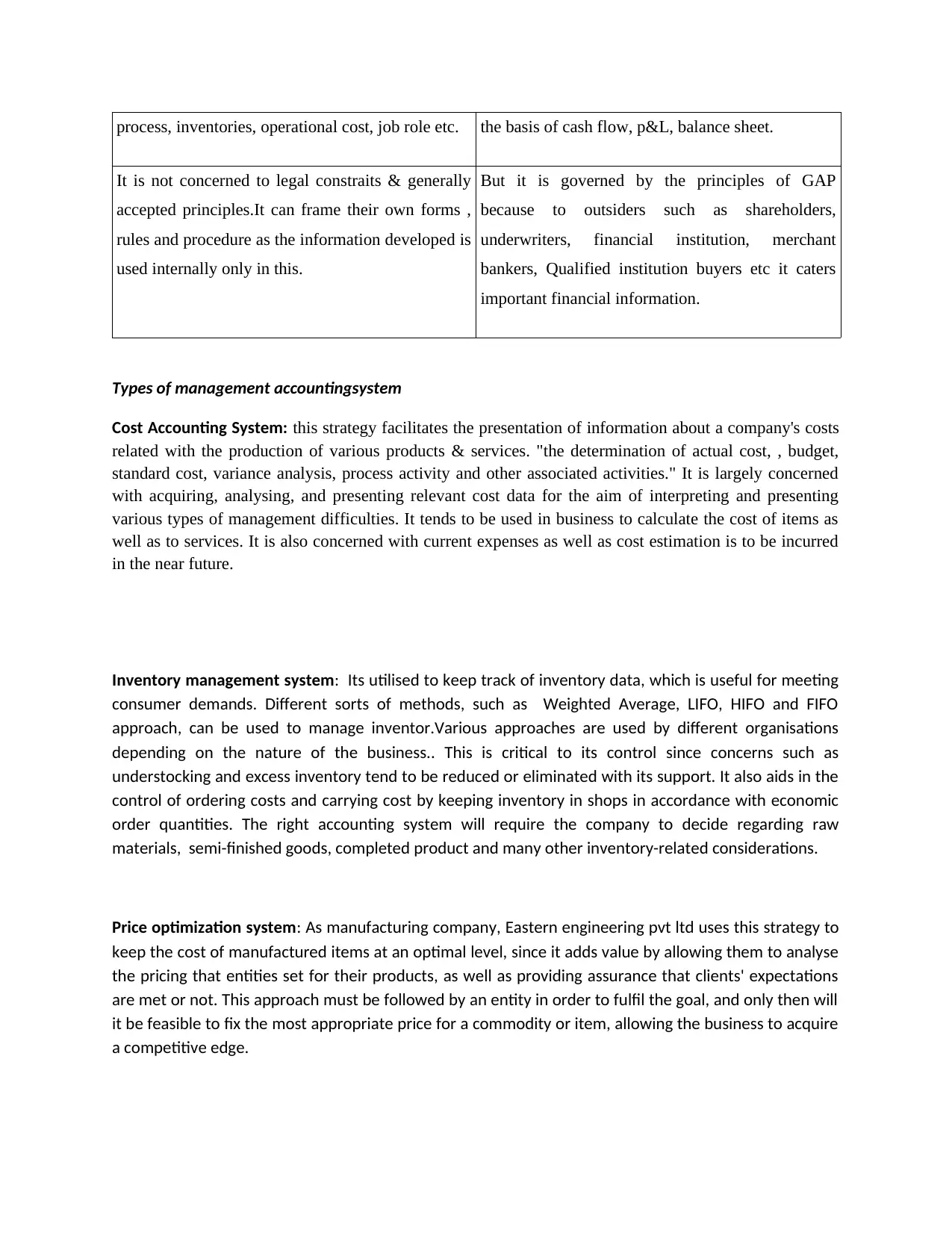
process, inventories, operational cost, job role etc. the basis of cash flow, p&L, balance sheet.
It is not concerned to legal constraits & generally
accepted principles.It can frame their own forms ,
rules and procedure as the information developed is
used internally only in this.
But it is governed by the principles of GAP
because to outsiders such as shareholders,
underwriters, financial institution, merchant
bankers, Qualified institution buyers etc it caters
important financial information.
Types of management accountingsystem
Cost Accounting System: this strategy facilitates the presentation of information about a company's costs
related with the production of various products & services. "the determination of actual cost, , budget,
standard cost, variance analysis, process activity and other associated activities." It is largely concerned
with acquiring, analysing, and presenting relevant cost data for the aim of interpreting and presenting
various types of management difficulties. It tends to be used in business to calculate the cost of items as
well as to services. It is also concerned with current expenses as well as cost estimation is to be incurred
in the near future.
Inventory management system: Its utilised to keep track of inventory data, which is useful for meeting
consumer demands. Different sorts of methods, such as Weighted Average, LIFO, HIFO and FIFO
approach, can be used to manage inventor.Various approaches are used by different organisations
depending on the nature of the business.. This is critical to its control since concerns such as
understocking and excess inventory tend to be reduced or eliminated with its support. It also aids in the
control of ordering costs and carrying cost by keeping inventory in shops in accordance with economic
order quantities. The right accounting system will require the company to decide regarding raw
materials, semi-finished goods, completed product and many other inventory-related considerations.
Price optimization system: As manufacturing company, Eastern engineering pvt ltd uses this strategy to
keep the cost of manufactured items at an optimal level, since it adds value by allowing them to analyse
the pricing that entities set for their products, as well as providing assurance that clients' expectations
are met or not. This approach must be followed by an entity in order to fulfil the goal, and only then will
it be feasible to fix the most appropriate price for a commodity or item, allowing the business to acquire
a competitive edge.
It is not concerned to legal constraits & generally
accepted principles.It can frame their own forms ,
rules and procedure as the information developed is
used internally only in this.
But it is governed by the principles of GAP
because to outsiders such as shareholders,
underwriters, financial institution, merchant
bankers, Qualified institution buyers etc it caters
important financial information.
Types of management accountingsystem
Cost Accounting System: this strategy facilitates the presentation of information about a company's costs
related with the production of various products & services. "the determination of actual cost, , budget,
standard cost, variance analysis, process activity and other associated activities." It is largely concerned
with acquiring, analysing, and presenting relevant cost data for the aim of interpreting and presenting
various types of management difficulties. It tends to be used in business to calculate the cost of items as
well as to services. It is also concerned with current expenses as well as cost estimation is to be incurred
in the near future.
Inventory management system: Its utilised to keep track of inventory data, which is useful for meeting
consumer demands. Different sorts of methods, such as Weighted Average, LIFO, HIFO and FIFO
approach, can be used to manage inventor.Various approaches are used by different organisations
depending on the nature of the business.. This is critical to its control since concerns such as
understocking and excess inventory tend to be reduced or eliminated with its support. It also aids in the
control of ordering costs and carrying cost by keeping inventory in shops in accordance with economic
order quantities. The right accounting system will require the company to decide regarding raw
materials, semi-finished goods, completed product and many other inventory-related considerations.
Price optimization system: As manufacturing company, Eastern engineering pvt ltd uses this strategy to
keep the cost of manufactured items at an optimal level, since it adds value by allowing them to analyse
the pricing that entities set for their products, as well as providing assurance that clients' expectations
are met or not. This approach must be followed by an entity in order to fulfil the goal, and only then will
it be feasible to fix the most appropriate price for a commodity or item, allowing the business to acquire
a competitive edge.
Paraphrase This Document
Need a fresh take? Get an instant paraphrase of this document with our AI Paraphraser
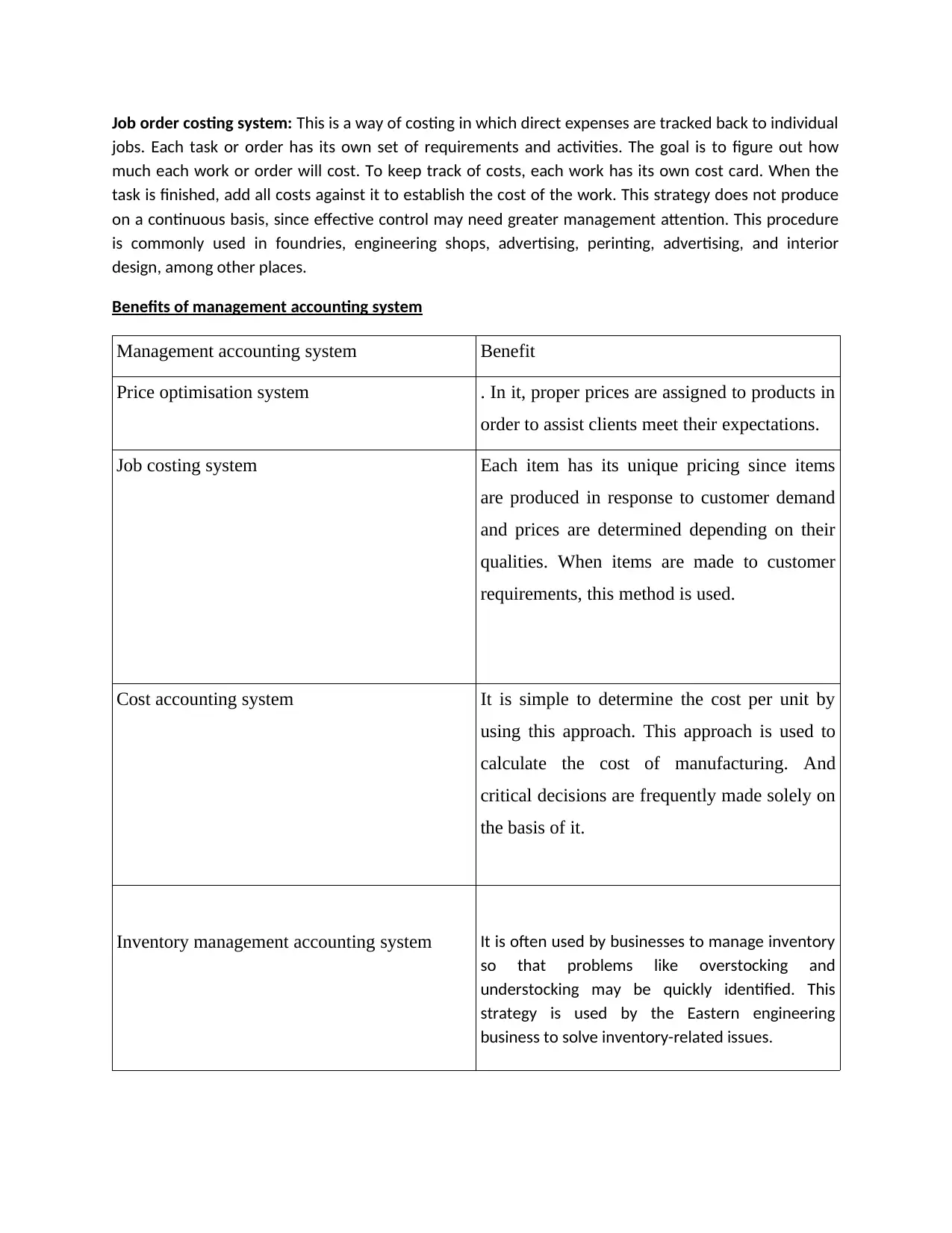
Job order costing system: This is a way of costing in which direct expenses are tracked back to individual
jobs. Each task or order has its own set of requirements and activities. The goal is to figure out how
much each work or order will cost. To keep track of costs, each work has its own cost card. When the
task is finished, add all costs against it to establish the cost of the work. This strategy does not produce
on a continuous basis, since effective control may need greater management attention. This procedure
is commonly used in foundries, engineering shops, advertising, perinting, advertising, and interior
design, among other places.
Benefits of management accounting system
Management accounting system Benefit
Price optimisation system . In it, proper prices are assigned to products in
order to assist clients meet their expectations.
Job costing system Each item has its unique pricing since items
are produced in response to customer demand
and prices are determined depending on their
qualities. When items are made to customer
requirements, this method is used.
Cost accounting system It is simple to determine the cost per unit by
using this approach. This approach is used to
calculate the cost of manufacturing. And
critical decisions are frequently made solely on
the basis of it.
Inventory management accounting system It is often used by businesses to manage inventory
so that problems like overstocking and
understocking may be quickly identified. This
strategy is used by the Eastern engineering
business to solve inventory-related issues.
jobs. Each task or order has its own set of requirements and activities. The goal is to figure out how
much each work or order will cost. To keep track of costs, each work has its own cost card. When the
task is finished, add all costs against it to establish the cost of the work. This strategy does not produce
on a continuous basis, since effective control may need greater management attention. This procedure
is commonly used in foundries, engineering shops, advertising, perinting, advertising, and interior
design, among other places.
Benefits of management accounting system
Management accounting system Benefit
Price optimisation system . In it, proper prices are assigned to products in
order to assist clients meet their expectations.
Job costing system Each item has its unique pricing since items
are produced in response to customer demand
and prices are determined depending on their
qualities. When items are made to customer
requirements, this method is used.
Cost accounting system It is simple to determine the cost per unit by
using this approach. This approach is used to
calculate the cost of manufacturing. And
critical decisions are frequently made solely on
the basis of it.
Inventory management accounting system It is often used by businesses to manage inventory
so that problems like overstocking and
understocking may be quickly identified. This
strategy is used by the Eastern engineering
business to solve inventory-related issues.
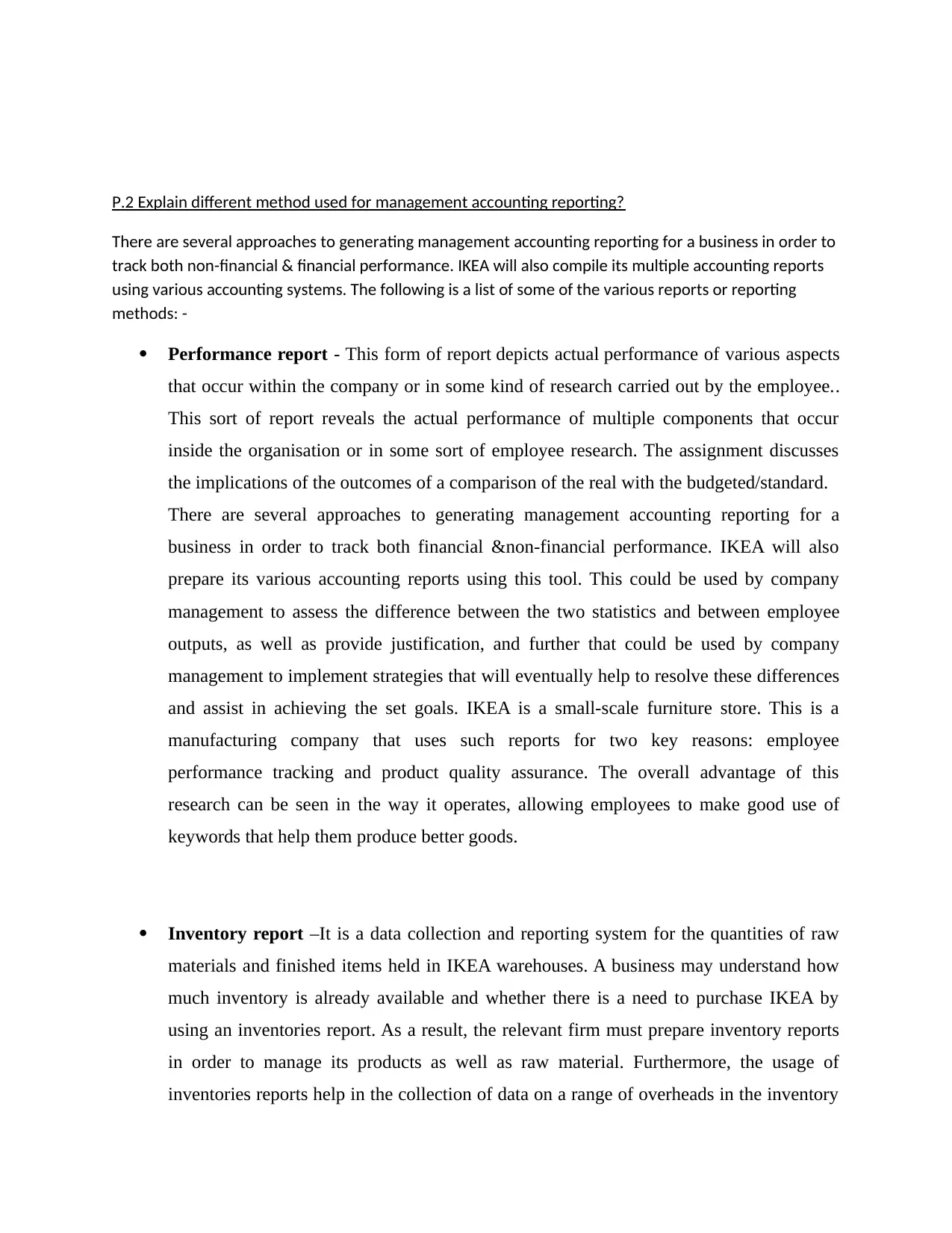
P.2 Explain different method used for management accounting reporting?
There are several approaches to generating management accounting reporting for a business in order to
track both non-financial & financial performance. IKEA will also compile its multiple accounting reports
using various accounting systems. The following is a list of some of the various reports or reporting
methods: -
Performance report - This form of report depicts actual performance of various aspects
that occur within the company or in some kind of research carried out by the employee..
This sort of report reveals the actual performance of multiple components that occur
inside the organisation or in some sort of employee research. The assignment discusses
the implications of the outcomes of a comparison of the real with the budgeted/standard.
There are several approaches to generating management accounting reporting for a
business in order to track both financial &non-financial performance. IKEA will also
prepare its various accounting reports using this tool. This could be used by company
management to assess the difference between the two statistics and between employee
outputs, as well as provide justification, and further that could be used by company
management to implement strategies that will eventually help to resolve these differences
and assist in achieving the set goals. IKEA is a small-scale furniture store. This is a
manufacturing company that uses such reports for two key reasons: employee
performance tracking and product quality assurance. The overall advantage of this
research can be seen in the way it operates, allowing employees to make good use of
keywords that help them produce better goods.
Inventory report –It is a data collection and reporting system for the quantities of raw
materials and finished items held in IKEA warehouses. A business may understand how
much inventory is already available and whether there is a need to purchase IKEA by
using an inventories report. As a result, the relevant firm must prepare inventory reports
in order to manage its products as well as raw material. Furthermore, the usage of
inventories reports help in the collection of data on a range of overheads in the inventory
There are several approaches to generating management accounting reporting for a business in order to
track both non-financial & financial performance. IKEA will also compile its multiple accounting reports
using various accounting systems. The following is a list of some of the various reports or reporting
methods: -
Performance report - This form of report depicts actual performance of various aspects
that occur within the company or in some kind of research carried out by the employee..
This sort of report reveals the actual performance of multiple components that occur
inside the organisation or in some sort of employee research. The assignment discusses
the implications of the outcomes of a comparison of the real with the budgeted/standard.
There are several approaches to generating management accounting reporting for a
business in order to track both financial &non-financial performance. IKEA will also
prepare its various accounting reports using this tool. This could be used by company
management to assess the difference between the two statistics and between employee
outputs, as well as provide justification, and further that could be used by company
management to implement strategies that will eventually help to resolve these differences
and assist in achieving the set goals. IKEA is a small-scale furniture store. This is a
manufacturing company that uses such reports for two key reasons: employee
performance tracking and product quality assurance. The overall advantage of this
research can be seen in the way it operates, allowing employees to make good use of
keywords that help them produce better goods.
Inventory report –It is a data collection and reporting system for the quantities of raw
materials and finished items held in IKEA warehouses. A business may understand how
much inventory is already available and whether there is a need to purchase IKEA by
using an inventories report. As a result, the relevant firm must prepare inventory reports
in order to manage its products as well as raw material. Furthermore, the usage of
inventories reports help in the collection of data on a range of overheads in the inventory
⊘ This is a preview!⊘
Do you want full access?
Subscribe today to unlock all pages.

Trusted by 1+ million students worldwide
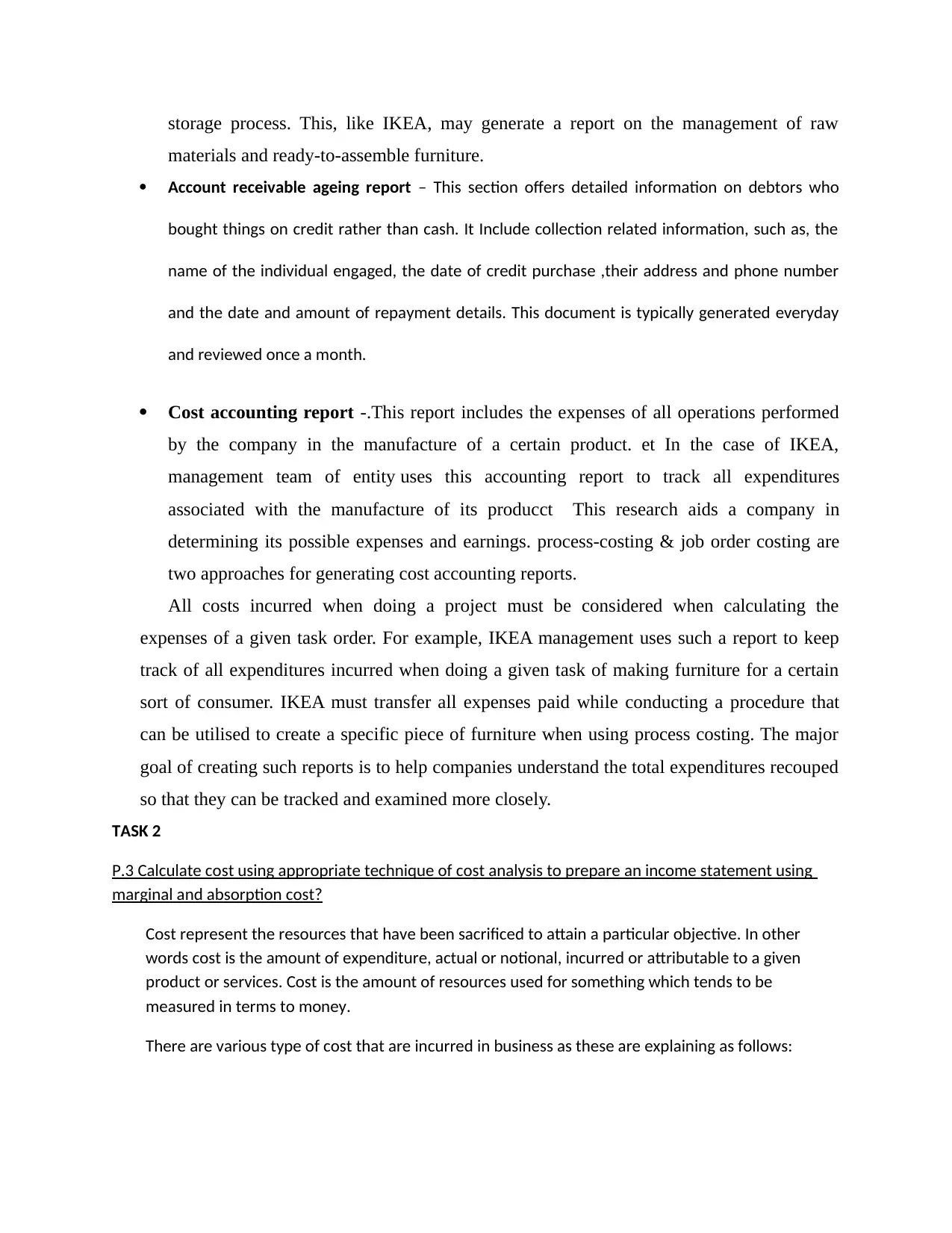
storage process. This, like IKEA, may generate a report on the management of raw
materials and ready-to-assemble furniture.
Account receivable ageing report – This section offers detailed information on debtors who
bought things on credit rather than cash. It Include collection related information, such as, the
name of the individual engaged, the date of credit purchase ,their address and phone number
and the date and amount of repayment details. This document is typically generated everyday
and reviewed once a month.
Cost accounting report -.This report includes the expenses of all operations performed
by the company in the manufacture of a certain product. et In the case of IKEA,
management team of entity uses this accounting report to track all expenditures
associated with the manufacture of its producct This research aids a company in
determining its possible expenses and earnings. process-costing & job order costing are
two approaches for generating cost accounting reports.
All costs incurred when doing a project must be considered when calculating the
expenses of a given task order. For example, IKEA management uses such a report to keep
track of all expenditures incurred when doing a given task of making furniture for a certain
sort of consumer. IKEA must transfer all expenses paid while conducting a procedure that
can be utilised to create a specific piece of furniture when using process costing. The major
goal of creating such reports is to help companies understand the total expenditures recouped
so that they can be tracked and examined more closely.
TASK 2
P.3 Calculate cost using appropriate technique of cost analysis to prepare an income statement using
marginal and absorption cost?
Cost represent the resources that have been sacrificed to attain a particular objective. In other
words cost is the amount of expenditure, actual or notional, incurred or attributable to a given
product or services. Cost is the amount of resources used for something which tends to be
measured in terms to money.
There are various type of cost that are incurred in business as these are explaining as follows:
materials and ready-to-assemble furniture.
Account receivable ageing report – This section offers detailed information on debtors who
bought things on credit rather than cash. It Include collection related information, such as, the
name of the individual engaged, the date of credit purchase ,their address and phone number
and the date and amount of repayment details. This document is typically generated everyday
and reviewed once a month.
Cost accounting report -.This report includes the expenses of all operations performed
by the company in the manufacture of a certain product. et In the case of IKEA,
management team of entity uses this accounting report to track all expenditures
associated with the manufacture of its producct This research aids a company in
determining its possible expenses and earnings. process-costing & job order costing are
two approaches for generating cost accounting reports.
All costs incurred when doing a project must be considered when calculating the
expenses of a given task order. For example, IKEA management uses such a report to keep
track of all expenditures incurred when doing a given task of making furniture for a certain
sort of consumer. IKEA must transfer all expenses paid while conducting a procedure that
can be utilised to create a specific piece of furniture when using process costing. The major
goal of creating such reports is to help companies understand the total expenditures recouped
so that they can be tracked and examined more closely.
TASK 2
P.3 Calculate cost using appropriate technique of cost analysis to prepare an income statement using
marginal and absorption cost?
Cost represent the resources that have been sacrificed to attain a particular objective. In other
words cost is the amount of expenditure, actual or notional, incurred or attributable to a given
product or services. Cost is the amount of resources used for something which tends to be
measured in terms to money.
There are various type of cost that are incurred in business as these are explaining as follows:
Paraphrase This Document
Need a fresh take? Get an instant paraphrase of this document with our AI Paraphraser
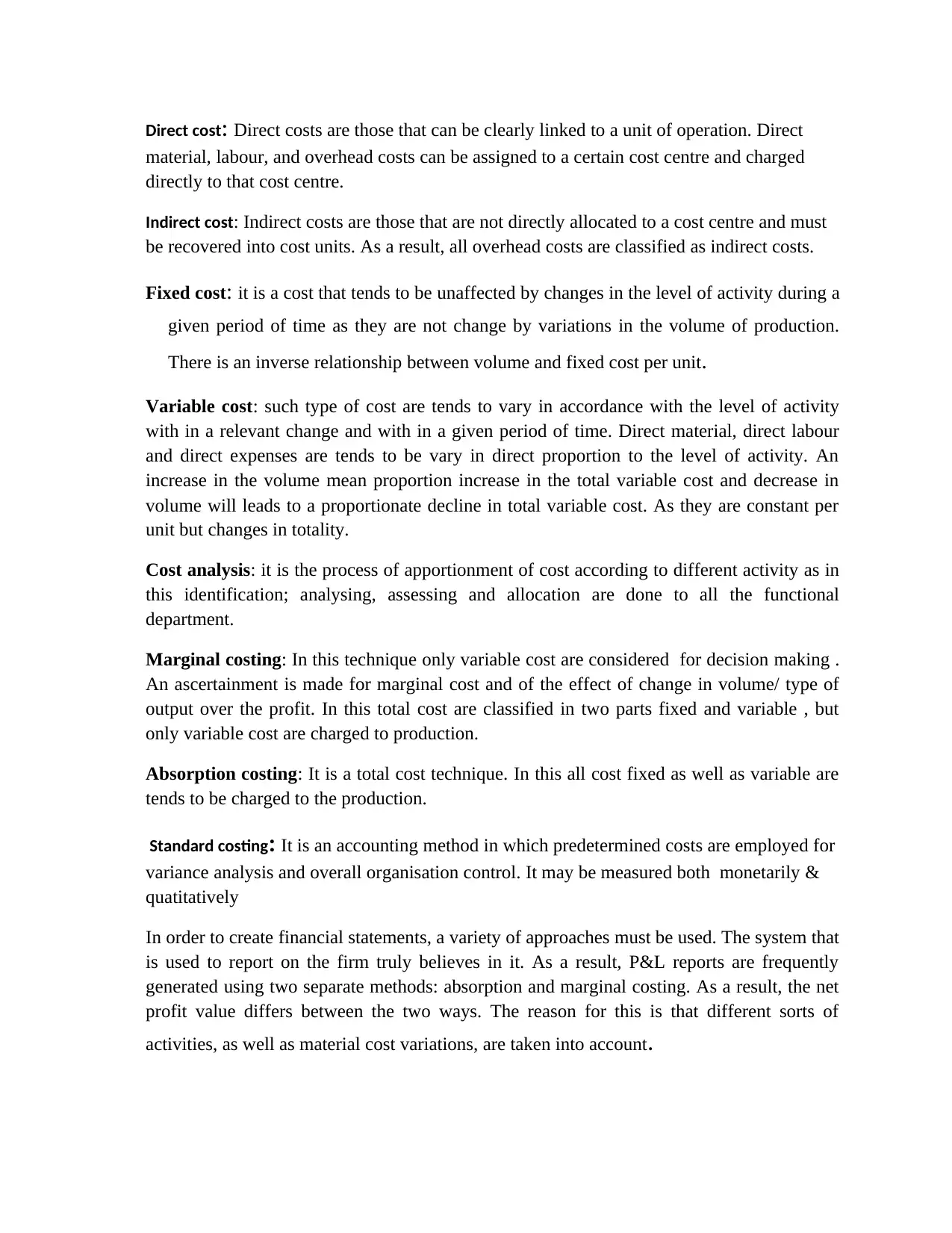
Direct cost: Direct costs are those that can be clearly linked to a unit of operation. Direct
material, labour, and overhead costs can be assigned to a certain cost centre and charged
directly to that cost centre.
Indirect cost: Indirect costs are those that are not directly allocated to a cost centre and must
be recovered into cost units. As a result, all overhead costs are classified as indirect costs.
Fixed cost: it is a cost that tends to be unaffected by changes in the level of activity during a
given period of time as they are not change by variations in the volume of production.
There is an inverse relationship between volume and fixed cost per unit.
Variable cost: such type of cost are tends to vary in accordance with the level of activity
with in a relevant change and with in a given period of time. Direct material, direct labour
and direct expenses are tends to be vary in direct proportion to the level of activity. An
increase in the volume mean proportion increase in the total variable cost and decrease in
volume will leads to a proportionate decline in total variable cost. As they are constant per
unit but changes in totality.
Cost analysis: it is the process of apportionment of cost according to different activity as in
this identification; analysing, assessing and allocation are done to all the functional
department.
Marginal costing: In this technique only variable cost are considered for decision making .
An ascertainment is made for marginal cost and of the effect of change in volume/ type of
output over the profit. In this total cost are classified in two parts fixed and variable , but
only variable cost are charged to production.
Absorption costing: It is a total cost technique. In this all cost fixed as well as variable are
tends to be charged to the production.
Standard costing: It is an accounting method in which predetermined costs are employed for
variance analysis and overall organisation control. It may be measured both monetarily &
quatitatively
In order to create financial statements, a variety of approaches must be used. The system that
is used to report on the firm truly believes in it. As a result, P&L reports are frequently
generated using two separate methods: absorption and marginal costing. As a result, the net
profit value differs between the two ways. The reason for this is that different sorts of
activities, as well as material cost variations, are taken into account.
material, labour, and overhead costs can be assigned to a certain cost centre and charged
directly to that cost centre.
Indirect cost: Indirect costs are those that are not directly allocated to a cost centre and must
be recovered into cost units. As a result, all overhead costs are classified as indirect costs.
Fixed cost: it is a cost that tends to be unaffected by changes in the level of activity during a
given period of time as they are not change by variations in the volume of production.
There is an inverse relationship between volume and fixed cost per unit.
Variable cost: such type of cost are tends to vary in accordance with the level of activity
with in a relevant change and with in a given period of time. Direct material, direct labour
and direct expenses are tends to be vary in direct proportion to the level of activity. An
increase in the volume mean proportion increase in the total variable cost and decrease in
volume will leads to a proportionate decline in total variable cost. As they are constant per
unit but changes in totality.
Cost analysis: it is the process of apportionment of cost according to different activity as in
this identification; analysing, assessing and allocation are done to all the functional
department.
Marginal costing: In this technique only variable cost are considered for decision making .
An ascertainment is made for marginal cost and of the effect of change in volume/ type of
output over the profit. In this total cost are classified in two parts fixed and variable , but
only variable cost are charged to production.
Absorption costing: It is a total cost technique. In this all cost fixed as well as variable are
tends to be charged to the production.
Standard costing: It is an accounting method in which predetermined costs are employed for
variance analysis and overall organisation control. It may be measured both monetarily &
quatitatively
In order to create financial statements, a variety of approaches must be used. The system that
is used to report on the firm truly believes in it. As a result, P&L reports are frequently
generated using two separate methods: absorption and marginal costing. As a result, the net
profit value differs between the two ways. The reason for this is that different sorts of
activities, as well as material cost variations, are taken into account.
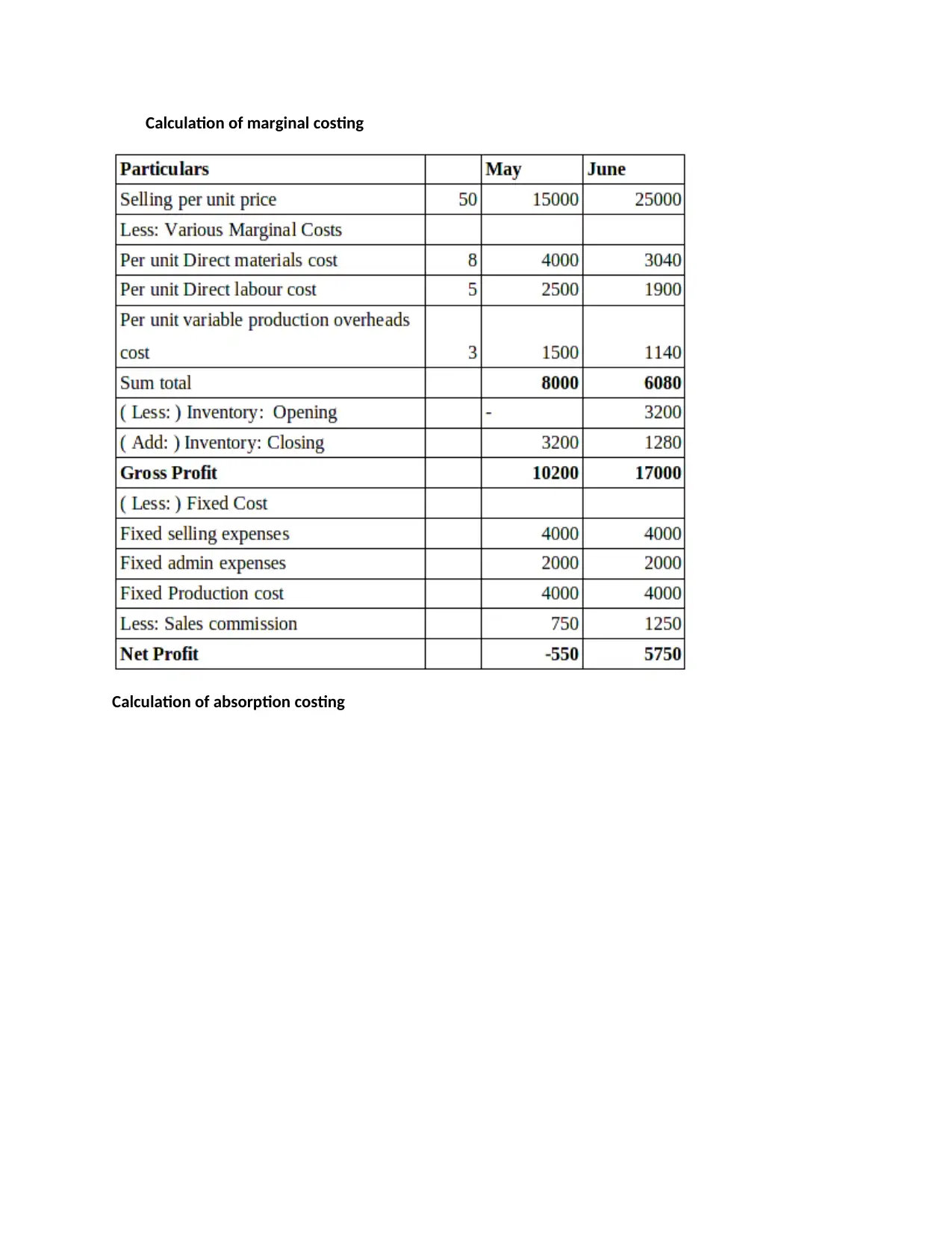
Calculation of marginal costing
Calculation of absorption costing
Calculation of absorption costing
⊘ This is a preview!⊘
Do you want full access?
Subscribe today to unlock all pages.

Trusted by 1+ million students worldwide
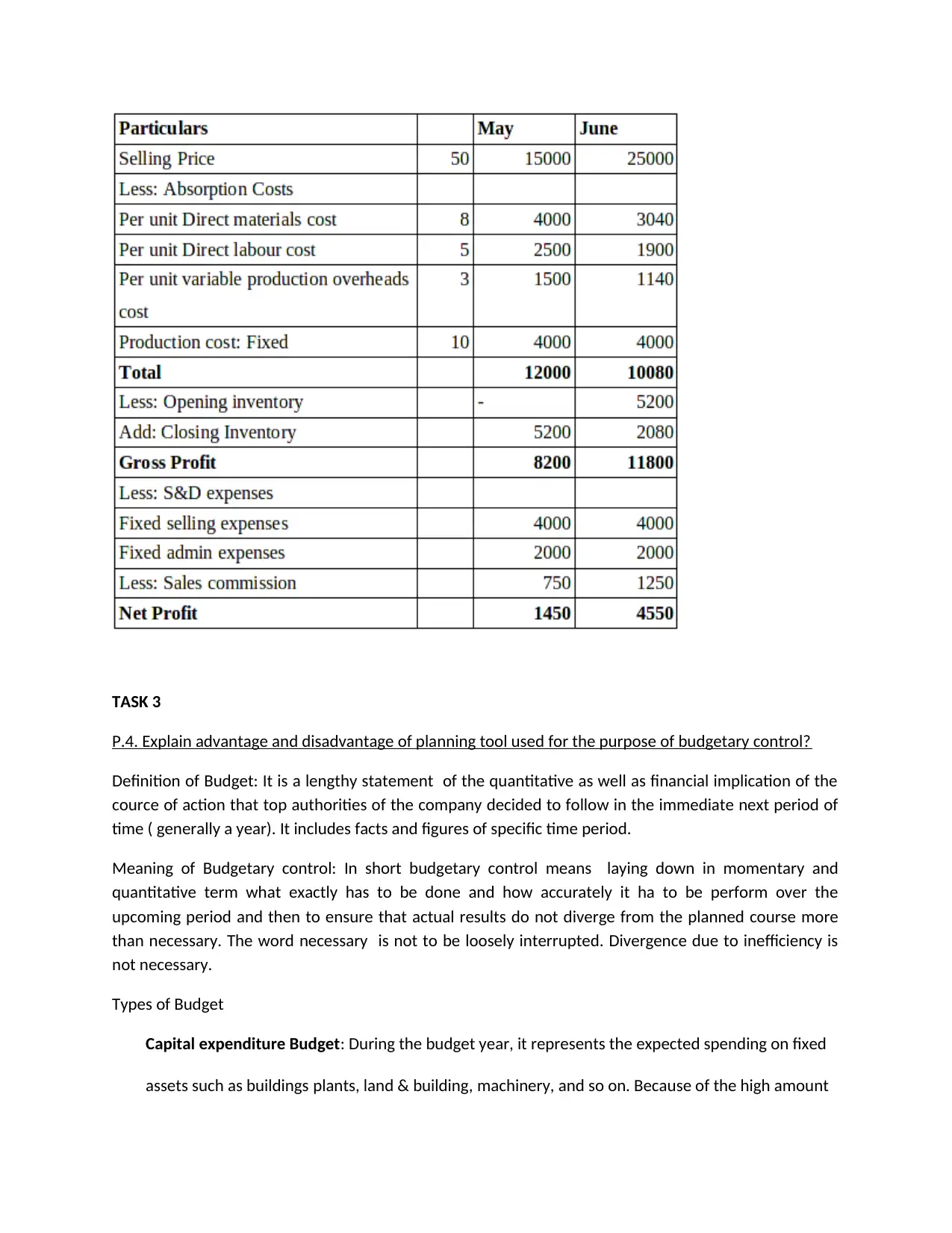
TASK 3
P.4. Explain advantage and disadvantage of planning tool used for the purpose of budgetary control?
Definition of Budget: It is a lengthy statement of the quantitative as well as financial implication of the
cource of action that top authorities of the company decided to follow in the immediate next period of
time ( generally a year). It includes facts and figures of specific time period.
Meaning of Budgetary control: In short budgetary control means laying down in momentary and
quantitative term what exactly has to be done and how accurately it ha to be perform over the
upcoming period and then to ensure that actual results do not diverge from the planned course more
than necessary. The word necessary is not to be loosely interrupted. Divergence due to inefficiency is
not necessary.
Types of Budget
Capital expenditure Budget: During the budget year, it represents the expected spending on fixed
assets such as buildings plants, land & building, machinery, and so on. Because of the high amount
P.4. Explain advantage and disadvantage of planning tool used for the purpose of budgetary control?
Definition of Budget: It is a lengthy statement of the quantitative as well as financial implication of the
cource of action that top authorities of the company decided to follow in the immediate next period of
time ( generally a year). It includes facts and figures of specific time period.
Meaning of Budgetary control: In short budgetary control means laying down in momentary and
quantitative term what exactly has to be done and how accurately it ha to be perform over the
upcoming period and then to ensure that actual results do not diverge from the planned course more
than necessary. The word necessary is not to be loosely interrupted. Divergence due to inefficiency is
not necessary.
Types of Budget
Capital expenditure Budget: During the budget year, it represents the expected spending on fixed
assets such as buildings plants, land & building, machinery, and so on. Because of the high amount
Paraphrase This Document
Need a fresh take? Get an instant paraphrase of this document with our AI Paraphraser
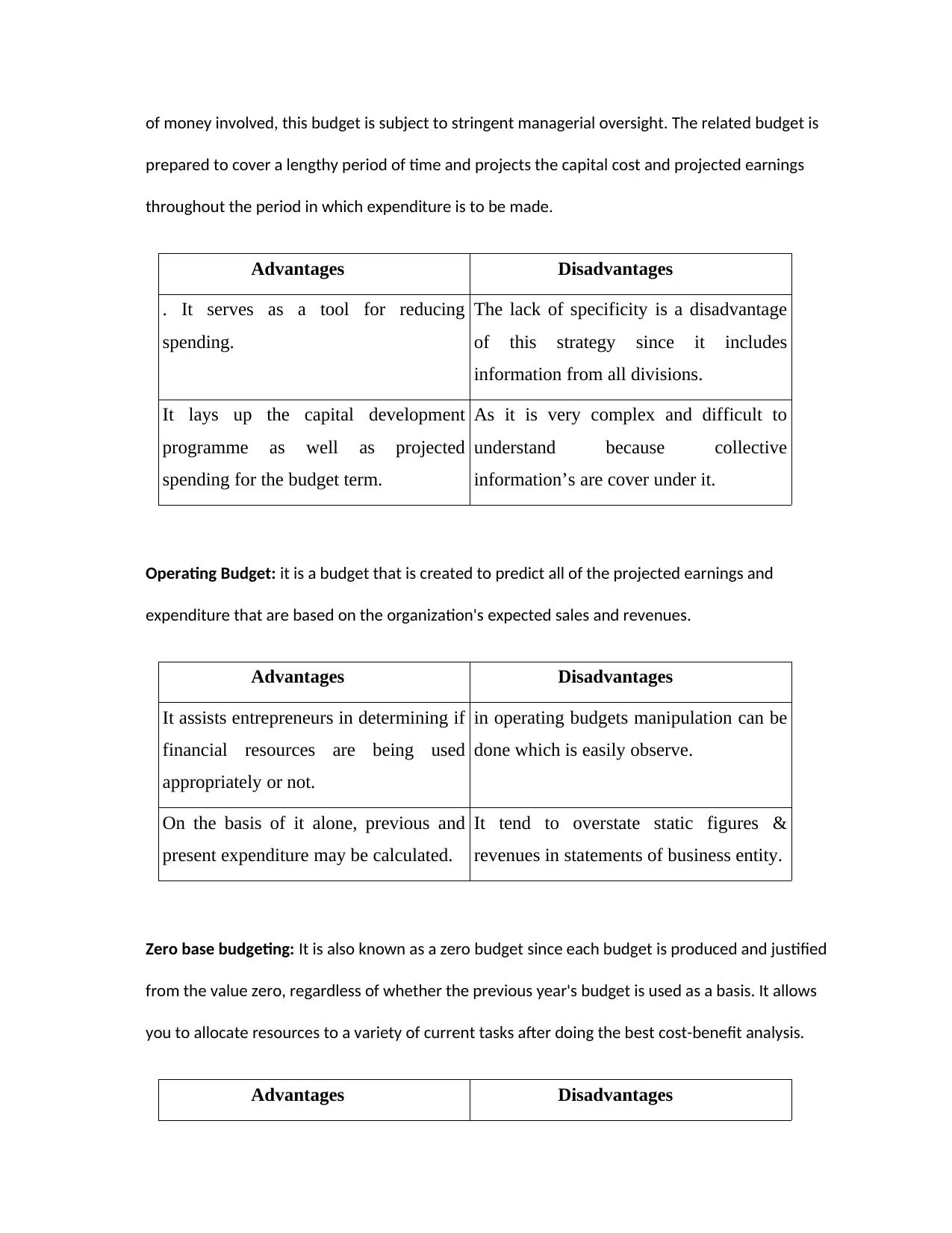
of money involved, this budget is subject to stringent managerial oversight. The related budget is
prepared to cover a lengthy period of time and projects the capital cost and projected earnings
throughout the period in which expenditure is to be made.
Advantages Disadvantages
. It serves as a tool for reducing
spending.
The lack of specificity is a disadvantage
of this strategy since it includes
information from all divisions.
It lays up the capital development
programme as well as projected
spending for the budget term.
As it is very complex and difficult to
understand because collective
information’s are cover under it.
Operating Budget: it is a budget that is created to predict all of the projected earnings and
expenditure that are based on the organization's expected sales and revenues.
Advantages Disadvantages
It assists entrepreneurs in determining if
financial resources are being used
appropriately or not.
in operating budgets manipulation can be
done which is easily observe.
On the basis of it alone, previous and
present expenditure may be calculated.
It tend to overstate static figures &
revenues in statements of business entity.
Zero base budgeting: It is also known as a zero budget since each budget is produced and justified
from the value zero, regardless of whether the previous year's budget is used as a basis. It allows
you to allocate resources to a variety of current tasks after doing the best cost-benefit analysis.
Advantages Disadvantages
prepared to cover a lengthy period of time and projects the capital cost and projected earnings
throughout the period in which expenditure is to be made.
Advantages Disadvantages
. It serves as a tool for reducing
spending.
The lack of specificity is a disadvantage
of this strategy since it includes
information from all divisions.
It lays up the capital development
programme as well as projected
spending for the budget term.
As it is very complex and difficult to
understand because collective
information’s are cover under it.
Operating Budget: it is a budget that is created to predict all of the projected earnings and
expenditure that are based on the organization's expected sales and revenues.
Advantages Disadvantages
It assists entrepreneurs in determining if
financial resources are being used
appropriately or not.
in operating budgets manipulation can be
done which is easily observe.
On the basis of it alone, previous and
present expenditure may be calculated.
It tend to overstate static figures &
revenues in statements of business entity.
Zero base budgeting: It is also known as a zero budget since each budget is produced and justified
from the value zero, regardless of whether the previous year's budget is used as a basis. It allows
you to allocate resources to a variety of current tasks after doing the best cost-benefit analysis.
Advantages Disadvantages
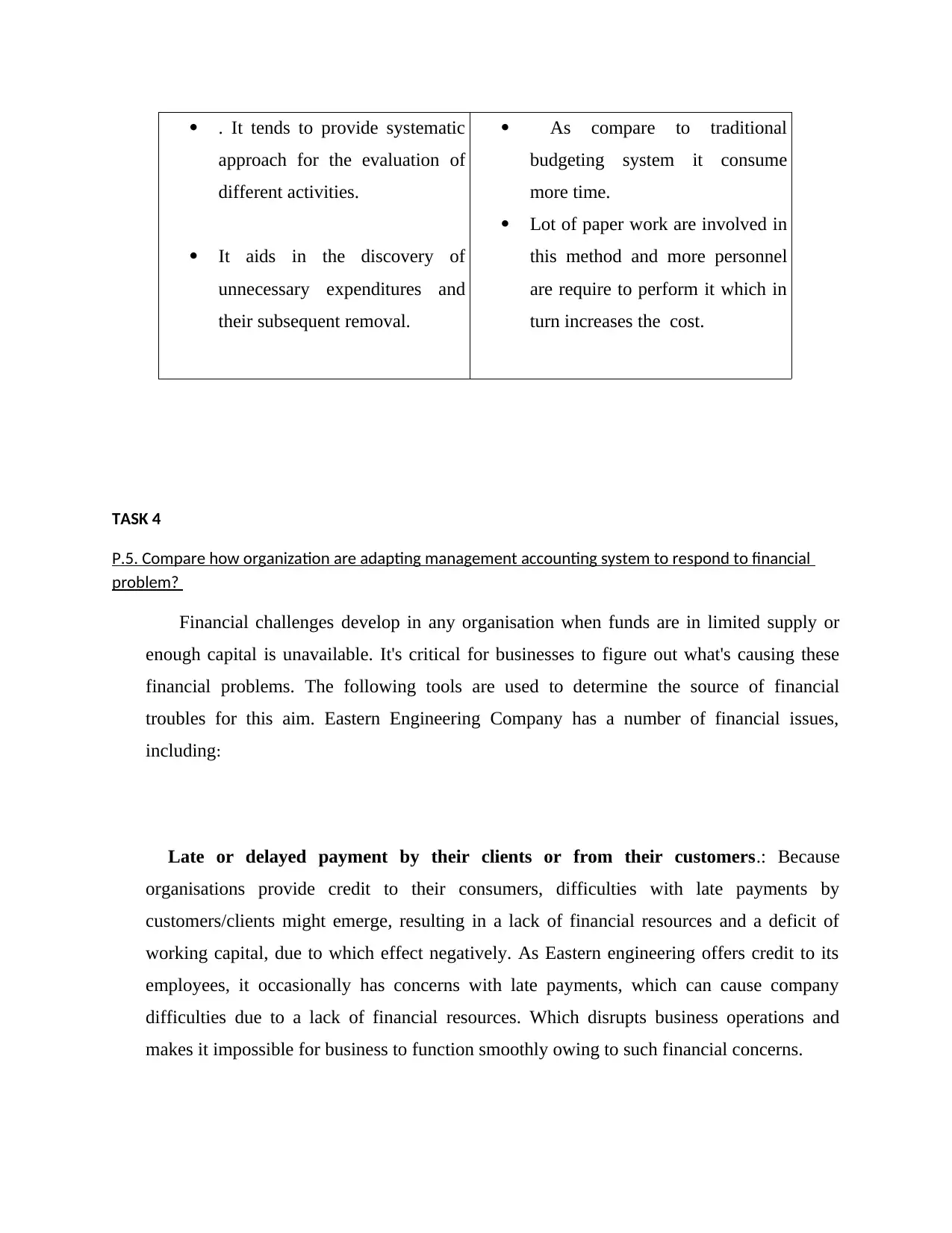
. It tends to provide systematic
approach for the evaluation of
different activities.
It aids in the discovery of
unnecessary expenditures and
their subsequent removal.
As compare to traditional
budgeting system it consume
more time.
Lot of paper work are involved in
this method and more personnel
are require to perform it which in
turn increases the cost.
TASK 4
P.5. Compare how organization are adapting management accounting system to respond to financial
problem?
Financial challenges develop in any organisation when funds are in limited supply or
enough capital is unavailable. It's critical for businesses to figure out what's causing these
financial problems. The following tools are used to determine the source of financial
troubles for this aim. Eastern Engineering Company has a number of financial issues,
including:
Late or delayed payment by their clients or from their customers.: Because
organisations provide credit to their consumers, difficulties with late payments by
customers/clients might emerge, resulting in a lack of financial resources and a deficit of
working capital, due to which effect negatively. As Eastern engineering offers credit to its
employees, it occasionally has concerns with late payments, which can cause company
difficulties due to a lack of financial resources. Which disrupts business operations and
makes it impossible for business to function smoothly owing to such financial concerns.
approach for the evaluation of
different activities.
It aids in the discovery of
unnecessary expenditures and
their subsequent removal.
As compare to traditional
budgeting system it consume
more time.
Lot of paper work are involved in
this method and more personnel
are require to perform it which in
turn increases the cost.
TASK 4
P.5. Compare how organization are adapting management accounting system to respond to financial
problem?
Financial challenges develop in any organisation when funds are in limited supply or
enough capital is unavailable. It's critical for businesses to figure out what's causing these
financial problems. The following tools are used to determine the source of financial
troubles for this aim. Eastern Engineering Company has a number of financial issues,
including:
Late or delayed payment by their clients or from their customers.: Because
organisations provide credit to their consumers, difficulties with late payments by
customers/clients might emerge, resulting in a lack of financial resources and a deficit of
working capital, due to which effect negatively. As Eastern engineering offers credit to its
employees, it occasionally has concerns with late payments, which can cause company
difficulties due to a lack of financial resources. Which disrupts business operations and
makes it impossible for business to function smoothly owing to such financial concerns.
⊘ This is a preview!⊘
Do you want full access?
Subscribe today to unlock all pages.

Trusted by 1+ million students worldwide
1 out of 17
Related Documents
Your All-in-One AI-Powered Toolkit for Academic Success.
+13062052269
info@desklib.com
Available 24*7 on WhatsApp / Email
![[object Object]](/_next/static/media/star-bottom.7253800d.svg)
Unlock your academic potential
Copyright © 2020–2025 A2Z Services. All Rights Reserved. Developed and managed by ZUCOL.





